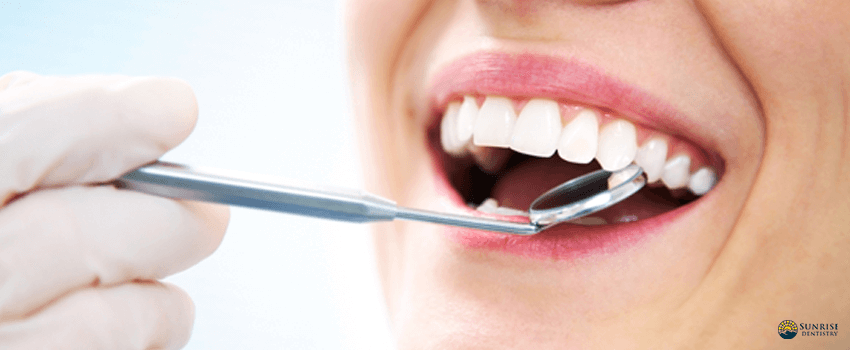Is the gum tissue covering your teeth starting to wear out and pull back, making your teeth look longer?
Your gums might be starting to recede, and soon, they will expose the roots of your teeth and create gaps between teeth where food debris and cavity-causing bacteria can accumulate.
Leaving gum recession untreated makes your teeth more susceptible to cavities and sensitivity. It will also lead to weak bone structure and eventual tooth loss.
Receding gums causes tooth sensitivity, discomfort, and pain around the gum line. They also cause gums to bleed when you floss or brush your teeth.
Gum recession is a common problem; in fact, 88% of people over 65 years old suffer from gum disease. However, most people don’t realize that they have receding gums.
Gum recession is a condition you should not ignore. The receding gum stage is the first stage of gum disease, making them dangerous.
What Causes Receding Gums?
Various factors can cause receding gums, which include:
Periodontal Disease
Gum disease is the leading cause of gum recession. They are infections caused by bacteria and can damage the supporting bone and gum tissues holding your teeth in place.
Genetics
Some people are more vulnerable to gum diseases and gum recession due to their genes. Studies show that 30% of the population are more predisposed to gum diseases, regardless of how well they take care of their teeth.
Misaligned Teeth
Crooked and unevenly spaced teeth can put pressure on the gums and bones supporting your teeth, making gums recede.
Poor Dental Hygiene
Poor brushing, flossing, and rinsing your mouth with mouthwash make it easy for plaque to become tartar, a hard substance that can accumulate between your teeth and gums. It can irritate the gums and cause gums to recede. Dental professionals are the only people who can remove tartar.
Teeth Grinding or Clenching
Gums can also recede due to the pressure caused by teeth grinding or clenching.
Hormonal Changes
Fluctuating hormones during pregnancy, puberty, and menopause can make a woman’s gums more sensitive to changes and increase the risk of gum recession.
Aggressive Oral Care
Brushing your teeth too hard can wear enamel down, causing your gums to recede.
Lip or Tongue Piercings
Piercings can irritate and rub the gums, which can wear down gum tissue and cause gums to recede.
Tobacco Products
People who smoke or chew tobacco products are more likely to have sticky plaque that is hard to remove, causing gum recession. Their gums also take time to heal.
How Are Receding Gums Diagnosed?
Dentists can diagnose gum recession during a routine examination using a periodontal probe, a special instrument that measures the extent of gum recession in each tooth.
Dentists also measure the periodontal pockets surrounding each tooth because gum recession is often accompanied by bone loss. Healthy pockets measure between one to three millimeters. Patients with gingivitis often have pockets measuring four millimeters, and those with periodontal disease have pockets measuring five millimeters and higher.
Receding Gums Treatment
Unfortunately, there is no way to grow receding gums back. However, you can take some steps to keep it from getting worse.
Tooth Scaling and Root Planing
Your dentist or hygienist carefully removes any tartar and plaque buildup below the gum line. They also make exposed tooth root areas smoother to make it more difficult for bacteria to stick to. They may also administer antibiotics to get rid of harmful bacteria in your mouth.
Open Flap Scaling and Root Planing
Gum surgery may be necessary to correct gum recession if deep cleaning doesn’t work or if you already have excessive tooth loss and deep pockets.
Open flap scaling and root planing is one surgery option dentists may offer. They fold back the gum tissue, remove the bacteria from the pockets, and secure the gum tissue over your tooth’s roots. This surgery also eliminates or reduces pocket sizes.
Regeneration
Your dentist or periodontist may also recommend a procedure to rebuild lost bone and tissue due to gum recession. In this procedure, your dentist or periodontist folds the affected gum tissue back and cleans the area to remove the bacteria. Then, they apply regenerative materials like membranes, graft tissue, or tissue-stimulating proteins that can encourage natural bone and tissue regeneration. Lastly, they secure the gum tissue to the root of the tooth.
Graft Surgery
Gum graft surgery is a predictable treatment option that will last. They are often performed by a periodontist, a dentist specializing in gums.
Periodontists use a gum graft to replace the damaged gum tissue. They usually take the graft from the roof of the mouth, but it can also come from sterilized human tissue from a donor.
They stitch the graft in place using one of many types of gum grafting methods. Your surgeon will help you choose the right one for you. Luckily, most of the gum grafting methods today are minimally invasive.
How to Stop Receding Gums
Avoiding gum recession is difficult, especially if you are predisposed to thin gum tissue. However, you can take steps to reduce its risk of developing.
1. Practice good oral hygiene.
Taking good care of your oral health prevents gum recession and other dental issues. Practice daily oral hygiene to keep your mouth healthy and free from bacteria buildup. Brush your teeth twice daily using fluoride toothpaste, and don’t forget to brush along the gum line. You can also use mouthwash to flush away bacteria and food debris.
Desensitizing toothpaste is the best toothpaste for receding gums. They can relieve the discomfort caused by gum recession.
Regular dental checkups are also an integral part of good oral hygiene. Scheduling regular appointments with your dentist ensures your gums and teeth stay healthy and prevent gum recession from worsening.
2. Use a mouth guard.
A mouth guard or splint can prevent nighttime teeth grinding and gum recession. Mouth guards apply pressure evenly across the jaw, separating the top and bottom teeth.
3. Practice gentle brushing.
Try to be gentle when you brush your teeth, especially if you tend to brush too hard. It also helps if you use a soft-bristled brush.
4. Watch what you consume.
A healthy diet can help keep your gums and teeth strong and healthy. Avoid sugary foods and drinks, and stop smoking. Tobacco products weaken the immune system and inhibit saliva flow, which increases the risk of developing gum disease and gum recession.
Key Takeaway
Gum recession is a common dental problem caused by different conditions like smoking, poor dental care, genetics, and hormonal changes. Dentists and periodontists can treat it by deep cleaning and surgery. However, the best thing to do is the prevent it from happening in the first place. Practice good oral hygiene and use a mouth guard if you clench or grind your teeth. You should also avoid brushing your teeth too hard and watch what you consume.
Prevent gum recession with Sunrise Dentistry.
Our dentists in Durango, CO, can provide preventive dentistry procedures to keep your teeth and gums healthy. They also practice holistic dentistry to care for your teeth. Call us today and start your journey to oral wellness.





